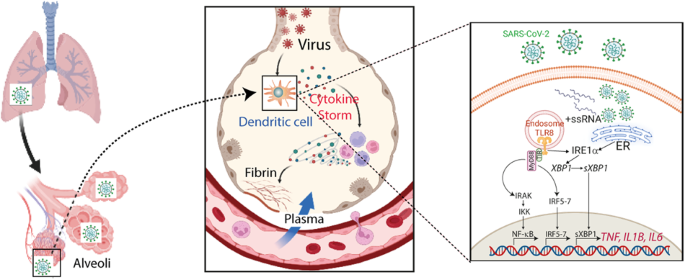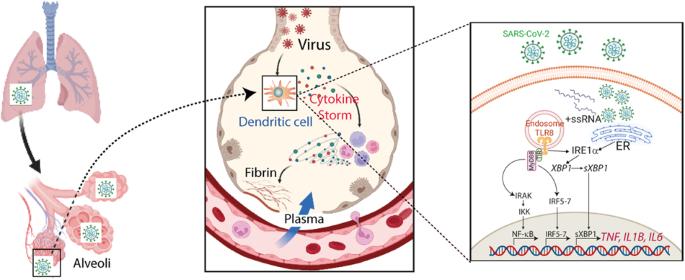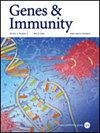Innate IRE1α-XBP1 activation by viral single-stranded RNA and its influence on lung cytokine production during SARS-CoV-2 pneumonia
IF 4.5
3区 医学
Q1 GENETICS & HEREDITY
引用次数: 0
Abstract
The utilization of host-cell machinery during SARS-CoV-2 infection can overwhelm the protein-folding capacity of the endoplasmic reticulum and activate the unfolded protein response (UPR). The IRE1α-XBP1 arm of the UPR could also be activated by viral RNA via Toll-like receptors. Based on these premises, a study to gain insight into the pathogenesis of COVID-19 disease was conducted using nasopharyngeal exudates and bronchioloalveolar aspirates. The presence of the mRNA of spliced XBP1 and a high expression of cytokine mRNAs were observed during active infection. TLR8 mRNA showed an overwhelming expression in comparison with TLR7 mRNA in bronchioloalveolar aspirates of COVID-19 patients, thus suggesting the presence of monocytes and monocyte-derived dendritic cells (MDDCs). In vitro experiments in MDDCs activated with ssRNA40, a synthetic mimic of SARS-CoV-2 RNA, showed induction of XBP1 splicing and the expression of proinflammatory cytokines. These responses were blunted by the IRE1α inhibitor MKC8866, the TLR8 antagonist CU-CPT9a, and knockdown of TLR8 receptor. In contrast, the IRE1α-XBP1 activator IXA4 enhanced these responses. Based on these findings, the TLR8/IRE1α system seems to play a significant role in the induction of the proinflammatory cytokines associated with severe COVID-19 disease and might be a druggable target to control cytokine storm.


病毒单链 RNA 激活先天 IRE1α-XBP1 及其对 SARS-CoV-2 肺炎期间肺细胞因子分泌的影响
在 SARS-CoV-2 感染过程中,宿主细胞机制的利用会使内质网的蛋白质折叠能力不堪重负,并激活未折叠蛋白反应(UPR)。UPR 的 IRE1α-XBP1 部分也可能被病毒 RNA 通过 Toll 样受体激活。基于这些前提,研究人员利用鼻咽渗出物和支气管肺泡吸出物对 COVID-19 疾病的发病机制进行了深入研究。在活动感染期间,观察到剪接 XBP1 mRNA 的存在和细胞因子 mRNA 的高表达。与 TLR7 mRNA 相比,TLR8 mRNA 在 COVID-19 患者支气管肺泡吸出物中的表达量更大,这表明存在单核细胞和单核细胞衍生树突状细胞(MDDCs)。用 ssRNA40(SARS-CoV-2 RNA 的合成模拟物)激活 MDDCs 的体外实验显示,诱导了 XBP1 剪接和促炎细胞因子的表达。这些反应被 IRE1α 抑制剂 MKC8866、TLR8 拮抗剂 CU-CPT9a 和 TLR8 受体敲除所抑制。相反,IRE1α-XBP1 激活剂 IXA4 则增强了这些反应。基于这些发现,TLR8/IRE1α系统似乎在诱导与严重COVID-19疾病相关的促炎细胞因子中发挥了重要作用,并可能成为控制细胞因子风暴的药物靶点。
本文章由计算机程序翻译,如有差异,请以英文原文为准。
求助全文
约1分钟内获得全文
求助全文
来源期刊

Genes and immunity
医学-免疫学
CiteScore
8.90
自引率
4.00%
发文量
28
审稿时长
6-12 weeks
期刊介绍:
Genes & Immunity emphasizes studies investigating how genetic, genomic and functional variations affect immune cells and the immune system, and associated processes in the regulation of health and disease. It further highlights articles on the transcriptional and posttranslational control of gene products involved in signaling pathways regulating immune cells, and protective and destructive immune responses.
 求助内容:
求助内容: 应助结果提醒方式:
应助结果提醒方式:


